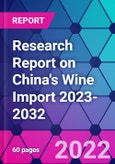In 2021, China imported 42,407.0 million liters of wine, down 1.4% year-on-year, and US$1.69 billion in import value, down 7.4% year-on-year. According to the publisher's analysis, in the first three quarters of 2022, China imported 264.835 million liters of wine, down 19.1% year-on-year, with an import value of US$1.10 billion, down 13.4% year-on-year.
According to the publisher's analysis, the types of wine imported into China are mainly sparkling wines and fresh grapes wines. In 2021, China imported 4,128,370,000 tons of fresh grapes wines, accounting for 97.4% of total imports and US$1.58 billion, or 93.3% of total imports. The publisher's analysis says that imports of fresh grapes wines are mainly wines in containers of less than 2 liters and in 2021, China imported 28.636 million liters of fresh grapes wines in containers liters, accounting for 67.5% of total imports and US$1.46 billion, or 86.2% of total imports.
South America and Europe are the main sources of wine imports into China. According to the publisher's analysis, China's main sources of wine imports by volume in 2021 are Chile, France, Spain, Italy and Argentina. Of these, Chile is the largest source of wine imports into China.
In 2021, China imported 127.155 million liters of Chilean wine, accounting for 30.0% of total imports and US$330 million, or 19.6% of total imports. The publisher analyzes that France is China's largest source of wine imports by volume. In 2021, China imported 114.964 million liters of French wine, accounting for 27.1% of total imports, and its imports amounted to US$750 million, accounting for 44.5% of total imports.
The publisher expects that China will continue to import large quantities of wine each year from 2023-2032 as the negative impact of COVID-19 on the Chinese economy wears off.
Topics covered:
- China's Wine Import Status and Major Sources in 2018-2022
- What is the Impact of COVID-19 on China's Wine Import?
- Which Companies are the Major Players in China's Wine Import Market and What are their Competitive Benchmarks?
- Key Drivers and Market Opportunities in China's Wine Import
- What are the Key Drivers, Challenges, and Opportunities for China's Wine Import during 2023-2032?
- What is the Expected Revenue of China's Wine Import during 2023-2032?
- What are the Strategies Adopted by the Key Players in the Market to Increase Their Market Share in the Industry?
- What are the Competitive Advantages of the Major Players in China's Wine Import Market?
- Which Segment of China's Wine Import is Expected to Dominate the Market in 2032?
- What are the Major Adverse Factors Facing China's Wine Import?
Table of Contents
Methodology
Background research defines the range of products and industries, which proposes the key points of the research. Proper classification will help clients understand the industry and products in the report.
Secondhand material research is a necessary way to push the project into fast progress. The analyst always chooses the data source carefully. Most secondhand data they quote is sourced from an authority in a specific industry or public data source from governments, industrial associations, etc. For some new or niche fields, they also "double-check" data sources and logics before they show them to clients.
Primary research is the key to solve questions, which largely influence the research outputs. The analyst may use methods like mathematics, logical reasoning, scenario thinking, to confirm key data and make the data credible.
The data model is an important analysis method. Calculating through data models with different factors weights can guarantee the outputs objective.
The analyst optimizes the following methods and steps in executing research projects and also forms many special information gathering and processing methods.
1. Analyze the life cycle of the industry to understand the development phase and space.
2. Grasp the key indexes evaluating the market to position clients in the market and formulate development plans
3. Economic, political, social and cultural factors
4. Competitors like a mirror that reflects the overall market and also market differences.
5. Inside and outside the industry, upstream and downstream of the industry chain, show inner competitions
6. Proper estimation of the future is good guidance for strategic planning.

LOADING...








